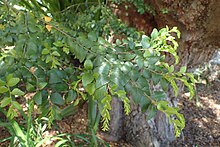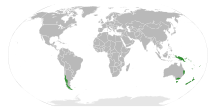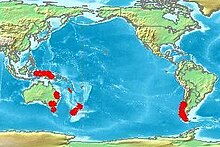
Back زان جنوبي Arabic زان جنوبى ARZ Notofaqus Azerbaijani Faig austral Catalan Nothofagus CEB Pabuk Czech Sydbøg Danish Scheinbuchen German Notofago Esperanto Lõunapöök Estonian
| Nothofagus Temporal range:
Late Cretaceous to recent | |
|---|---|

| |
| Nothofagus cunninghamii, Eastern Australia. | |
| Scientific classification | |
| Kingdom: | Plantae |
| Clade: | Tracheophytes |
| Clade: | Angiosperms |
| Clade: | Eudicots |
| Clade: | Rosids |
| Order: | Fagales |
| Family: | Nothofagaceae Kuprian.[1] |
| Genus: | Nothofagus Blume |

| |
| The range of Nothofagus. | |
| Synonyms[2] | |
| |



Nothofagus, also known as the southern beeches, is a genus of 43 species[3] of trees and shrubs native to the Southern Hemisphere in southern South America (Chile, Argentina) and east and southeast Australia, New Zealand, New Guinea, and New Caledonia. The species are ecological dominants in many temperate forests in these regions.[4] Some species are reportedly naturalised in Germany and Great Britain.[5] The genus has a rich fossil record of leaves, cupules, and pollen, with fossils extending into the late Cretaceous period and occurring in Australia, New Zealand, Antarctica, and South America.[6]
- ^ Angiosperm Phylogeny Group (2009). "An update of the Angiosperm Phylogeny Group classification for the orders and families of flowering plants: APG III". Botanical Journal of the Linnean Society. 161 (2): 105–121. doi:10.1111/j.1095-8339.2009.00996.x. hdl:10654/18083.
- ^ "Nothofagus". Plants of the World Online - Kew Science. Retrieved 19 April 2023.
- ^ Christenhusz, M. J. M.; Byng, J. W. (2016). "The number of known plants species in the world and its annual increase". Phytotaxa. 261 (3): 201–217. doi:10.11646/phytotaxa.261.3.1.
- ^ Veblen, Thomas; Hill, Robert; Read, Jennifer (1996). Ecology and Biogeography of Nothofagus Forests. New Haven, CT: Yale University Press. ISBN 978-0-300-06423-0.
- ^ Kew World Checklist of Selected Plant Families
- ^ Hill, Robert (2001). "Biogeography, evolution and palaeoecology of Nothofagus (Nothofagaceae): The contribution of the fossil record". Australian Journal of Botany. 49 (3): 321. doi:10.1071/BT00026.